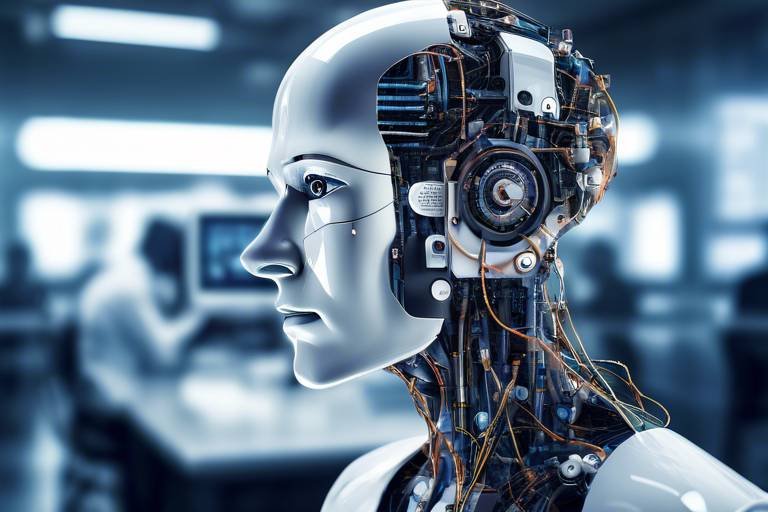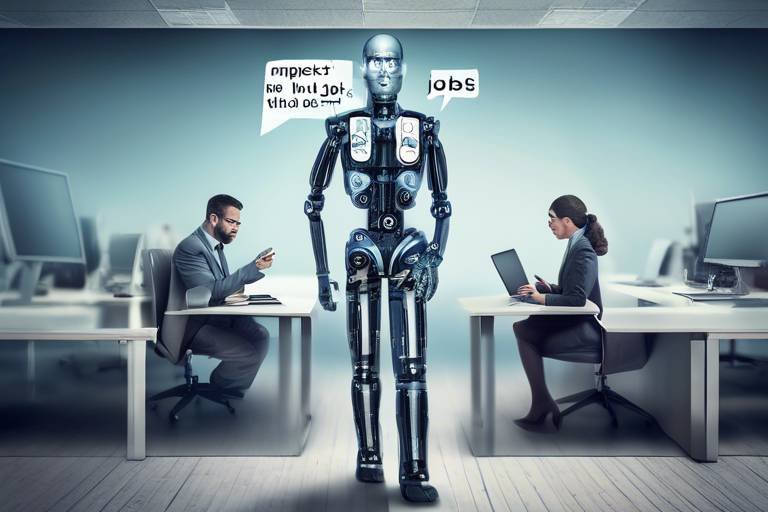3D Printing’s Impact on the Manufacturing Industry
3D printing, or additive manufacturing as it's often called, is not just a buzzword; it's a game changer in the manufacturing landscape. Imagine a world where products are created layer by layer, allowing for intricate designs that were once deemed impossible. This technology is revolutionizing how we think about production, pushing the boundaries of what can be made and how quickly it can be done. It's like having a magic wand that brings your ideas to life, and businesses are starting to realize its potential.
The impact of 3D printing on the manufacturing industry is profound. It enhances efficiency, reduces costs, and enables innovative designs that cater to specific needs. In traditional manufacturing, creating a prototype can take weeks, if not months, involving multiple processes and significant material waste. However, with 3D printing, this process can be condensed into days or even hours. This shift not only accelerates the development cycle but also allows for rapid testing and iteration, leading to better products in less time.
Moreover, the ability to produce complex geometries means that manufacturers can create lighter, stronger parts that optimize performance. Think of the aerospace industry, where every gram counts. With 3D printing, companies can design components that are not only functional but also incredibly lightweight, improving fuel efficiency and lowering costs. This technology is paving the way for a new era of manufacturing where creativity meets practicality.
However, it's not all smooth sailing. As with any emerging technology, there are challenges to overcome. Initial costs of 3D printers and materials can be high, and the range of materials suitable for printing is still limited compared to traditional manufacturing methods. Additionally, regulatory hurdles can pose significant barriers, especially in industries like healthcare and aerospace, where safety and compliance are paramount. Addressing these challenges is crucial for the broader adoption of 3D printing in manufacturing.
As we look ahead, the potential applications of 3D printing are virtually limitless. Industries such as automotive, healthcare, and consumer goods are already harnessing this technology to innovate and improve their product offerings. For instance, in healthcare, 3D printing is being used to create customized implants and prosthetics tailored to individual patients, enhancing the quality of care. In the automotive sector, manufacturers are utilizing 3D printing for rapid prototyping and even end-use parts, streamlining their production processes.
Furthermore, the integration of 3D printing into supply chain management is transforming how products are delivered to consumers. By reducing lead times and minimizing inventory costs, businesses can operate more efficiently. Imagine a world where spare parts can be printed on demand, eliminating the need for large warehouses filled with stock. This shift is not just a trend; it's a fundamental change in how supply chains are managed.
Looking towards the future, we can expect exciting advancements in 3D printing technology. Innovations in materials, increased automation, and integration with artificial intelligence are on the horizon. These developments promise to enhance the capabilities of 3D printing, making it an even more integral part of the manufacturing process.
To illustrate the real-world impact of 3D printing, let’s take a look at some case studies of successful implementation. Companies like Boeing, Adidas, and GE have embraced this technology, showcasing its potential to revolutionize production. For example, Boeing has utilized 3D printing to produce lightweight components for aircraft, significantly reducing manufacturing time and costs. Adidas has created customized footwear using 3D printing, allowing for a personalized fit that enhances performance. These examples highlight the versatility and effectiveness of 3D printing across various sectors.
- What is 3D printing? 3D printing is a manufacturing process that creates three-dimensional objects by layering materials based on digital models.
- What are the benefits of 3D printing? Benefits include reduced material waste, faster prototyping, and the ability to create complex designs.
- What industries are using 3D printing? Industries such as aerospace, automotive, healthcare, and consumer goods are leveraging 3D printing for innovation.
- What challenges does 3D printing face? Challenges include high initial costs, material limitations, and regulatory hurdles that must be addressed for wider adoption.
- What does the future hold for 3D printing? The future includes advancements in materials, automation, and AI integration, enhancing its role in manufacturing.

Introduction to 3D Printing
3D printing, often referred to as additive manufacturing, is a groundbreaking technology that is changing the way we think about creating objects. Imagine a world where you can design anything from a simple toy to a complex airplane part, and then watch as it materializes right before your eyes. This innovative process involves building three-dimensional objects layer by layer, using various materials such as plastics, metals, and even biological substances. The beauty of 3D printing lies in its ability to bring your ideas to life with incredible precision and speed.
At its core, the 3D printing process begins with a digital model, typically created using computer-aided design (CAD) software. Once the model is ready, it is sliced into thin horizontal layers by specialized software, which the 3D printer then uses as a blueprint to construct the object. This method contrasts sharply with traditional manufacturing techniques, which often involve cutting away material from a solid block (subtractive manufacturing). The result? Less waste, more creativity, and a whole new realm of possibilities.
To better understand the impact of 3D printing, consider the following key aspects:
- Customization: Each item can be uniquely tailored to meet specific needs, whether it's a custom prosthetic limb or a personalized piece of jewelry.
- Speed: Prototyping can be completed in a fraction of the time it takes using traditional methods, allowing for rapid iterations and faster time-to-market.
- Cost-Effectiveness: While the initial investment in a 3D printer can be high, the long-term savings from reduced material waste and lower labor costs can be substantial.
As we delve deeper into the world of 3D printing, it’s essential to grasp not just its mechanics, but also the profound implications it holds for the manufacturing industry. This technology is not just a fad; it’s a revolution that is reshaping how we approach design, production, and even distribution. The potential applications are vast, spanning industries from healthcare to aerospace, and its impact is only expected to grow in the coming years.
In summary, 3D printing is more than just a manufacturing tool; it's a gateway to innovation. By understanding its fundamentals, we can better appreciate its transformative power and the new opportunities it presents for both businesses and consumers alike. So, buckle up as we explore the many benefits, challenges, and future potential of this exciting technology!

Benefits of 3D Printing
When we dive into the world of 3D printing, it’s hard not to be amazed by the myriad of benefits it brings to the manufacturing table. Imagine a world where products are not just ideas sketched on paper but tangible objects that can be created with a few clicks. This technology, also known as additive manufacturing, is revolutionizing the way we think about production. One of the most significant advantages is the reduction of material waste. Traditional manufacturing methods often involve cutting away material from a larger block, which can lead to significant waste. In contrast, 3D printing builds objects layer by layer, using only the material necessary to create the final product.
Another standout benefit is faster prototyping. In the past, developing a prototype could take weeks or even months, involving multiple iterations and revisions. With 3D printing, companies can produce prototypes in a fraction of the time. This speed allows for rapid testing and adjustments, enabling businesses to bring their products to market much faster. Think of it as having a fast pass at an amusement park—suddenly, the long wait is a thing of the past!
Moreover, 3D printing allows for the creation of complex geometries that would be impossible or extremely costly with traditional manufacturing methods. Designers can let their creativity run wild, producing intricate designs that not only look good but also perform better. For instance, in the aerospace industry, 3D printing has enabled the creation of lightweight components that help improve fuel efficiency without sacrificing strength. This ability to innovate is reshaping industries and pushing the boundaries of what’s possible.
Additionally, 3D printing enhances customization. In a market that increasingly values personalized products, this technology allows manufacturers to create items tailored to specific customer needs. Whether it’s a custom-fit orthopedic device in healthcare or bespoke components in automotive, the possibilities are endless. This level of personalization not only increases customer satisfaction but also fosters brand loyalty.
In terms of cost efficiency, while the initial investment in 3D printing technology might seem daunting, the long-term savings are undeniable. Companies can save on labor costs, reduce storage needs due to on-demand manufacturing, and minimize shipping expenses by producing items closer to the end user. This shift toward localized production can dramatically transform how businesses operate.
In summary, the benefits of 3D printing are vast and varied. From reducing waste and speeding up prototyping to enabling complex designs and customization, this technology is not just a trend; it’s a fundamental shift in manufacturing. As we continue to explore its potential, it’s clear that 3D printing is here to stay, and its impact will only grow stronger in the years to come.
- What industries benefit the most from 3D printing? Industries like aerospace, automotive, healthcare, and consumer goods are leading the charge in adopting 3D printing technologies.
- Is 3D printing cost-effective for small businesses? Yes, while the initial investment can be high, the long-term savings and customization options can make it very cost-effective for small businesses.
- Can 3D printing be used for mass production? While traditionally used for prototyping, advancements in technology are making mass production via 3D printing increasingly viable.

Challenges in Implementing 3D Printing
While the promise of 3D printing in the manufacturing sector is indeed enticing, it’s not without its hurdles. One of the most significant challenges is the high initial investment cost. Setting up a 3D printing operation often requires substantial capital for purchasing state-of-the-art printers, materials, and software. For many small and medium-sized enterprises (SMEs), this upfront cost can be a daunting barrier. Imagine wanting to dive into a pool but being held back by the height of the diving board; that’s how many businesses feel when considering 3D printing.
In addition to financial constraints, there are material limitations that can hinder the widespread adoption of 3D printing. Not all materials are suitable for 3D printing, and those that are often come with their own sets of challenges. For instance, while plastics are widely used, they may not provide the strength or durability required for certain applications. On the other hand, metals can be expensive and require specialized equipment to print. This limitation can restrict the types of products that can be manufactured using this technology.
Another significant challenge lies in the regulatory hurdles that accompany the use of 3D printing, especially in industries like healthcare and aerospace. These sectors are heavily regulated to ensure safety and compliance. As a result, companies must navigate a complex web of regulations, which can slow down the implementation process. It's like trying to drive through a maze; one wrong turn can lead to delays and increased costs.
Moreover, the skills gap in the workforce poses a considerable challenge. The successful implementation of 3D printing technology requires a workforce that is not only familiar with the technology but also skilled in design and engineering principles. Unfortunately, many companies find it difficult to recruit or train employees with the necessary expertise. This skills gap can lead to inefficiencies and hinder the overall effectiveness of 3D printing initiatives.
Lastly, there is the challenge of intellectual property (IP) concerns. As 3D printing allows for the easy replication of designs, companies may find themselves at risk of having their proprietary designs copied. This is particularly concerning for industries that rely heavily on unique designs and patents. The legal landscape surrounding IP in the realm of 3D printing is still evolving, and companies must tread carefully to protect their innovations.
In summary, while 3D printing holds immense potential, companies must address these challenges head-on. Overcoming the high costs, material limitations, regulatory issues, skills gap, and IP concerns will be crucial for the broader adoption of this revolutionary technology in the manufacturing industry.
- What is the primary challenge of 3D printing?
The primary challenges include high initial costs, material limitations, regulatory hurdles, skills gaps, and intellectual property concerns. - How does 3D printing affect production costs?
While 3D printing can reduce material waste and streamline production, the initial setup costs can be high, impacting overall production costs. - Are there any industries that are particularly resistant to 3D printing?
Industries with strict regulations, such as healthcare and aerospace, may face more challenges in adopting 3D printing due to compliance issues. - Can 3D printing be used for mass production?
While 3D printing excels in prototyping and small batch production, it is still being evaluated for large-scale mass production due to speed and cost factors.

Applications in Various Industries
3D printing is not just a buzzword; it's a game-changer across numerous industries. From aerospace to healthcare, this innovative technology is reshaping how products are made and services are delivered. Imagine being able to produce complex parts for an aircraft directly from a digital file, eliminating the need for traditional manufacturing methods. In the aerospace sector, companies like Boeing and Airbus are utilizing 3D printing to create lightweight components that enhance fuel efficiency and reduce costs. This shift not only speeds up production but also allows for greater design freedom, leading to more efficient aircraft.
In the automotive industry, manufacturers are harnessing the power of 3D printing for rapid prototyping and custom parts production. Ford and General Motors are at the forefront, using additive manufacturing to create prototypes that can be tested and modified quickly, drastically reducing the time it takes to bring a new vehicle to market. Additionally, 3D printing allows for the creation of intricate designs that would be impossible or prohibitively expensive to achieve with traditional methods.
When it comes to healthcare, the implications of 3D printing are nothing short of revolutionary. Surgeons can now create patient-specific implants and prosthetics tailored to individual anatomical structures. This customization not only improves patient outcomes but also enhances the overall experience. For instance, companies like Stratasys are producing 3D-printed surgical models that allow doctors to plan complex procedures with unparalleled precision.
Moreover, the consumer goods sector is seeing a surge in 3D printing applications, especially in the production of personalized products. From customized phone cases to bespoke jewelry, companies are leveraging this technology to cater to individual consumer preferences. The ability to produce small batches of unique items without the overhead costs associated with traditional manufacturing is a significant advantage. This trend is pushing brands to rethink their production strategies and engage with customers in more meaningful ways.
To illustrate the diverse applications of 3D printing across these industries, consider the following table:
| Industry | Application | Example Companies |
|---|---|---|
| Aerospace | Production of lightweight components | Boeing, Airbus |
| Automotive | Rapid prototyping and custom parts | Ford, General Motors |
| Healthcare | Patient-specific implants and surgical models | Stratasys, Organovo |
| Consumer Goods | Personalized products | Shapeways, Etsy sellers |
The versatility of 3D printing technology is evident in its ability to adapt to various needs and challenges across different sectors. As we continue to explore its potential, it’s clear that 3D printing is not just a fleeting trend but a fundamental shift in how industries operate. The future is bright, with endless possibilities for innovation and efficiency.
Q1: What industries benefit the most from 3D printing?
A1: Industries such as aerospace, automotive, healthcare, and consumer goods are among the primary beneficiaries of 3D printing technology. Each of these sectors utilizes 3D printing to enhance efficiency, reduce costs, and innovate product offerings.
Q2: How does 3D printing reduce material waste?
A2: Traditional manufacturing often involves cutting away material from a larger block, which can lead to significant waste. In contrast, 3D printing builds objects layer by layer, using only the material needed for the final product, thus minimizing waste.
Q3: Are there any limitations to 3D printing?
A3: Yes, while 3D printing offers many advantages, challenges include high initial costs, limitations in material types, and regulatory hurdles, especially in industries like healthcare.
Q4: What is the future of 3D printing?
A4: The future of 3D printing looks promising, with advancements in materials, automation, and integration with artificial intelligence expected to further enhance its role in manufacturing and other industries.

Impact on Supply Chain Management
The integration of 3D printing into supply chain management is nothing short of a game-changer. Imagine a world where products can be created on demand, reducing the need for extensive inventories and lengthy lead times. This is not just a dream—it's becoming a reality as companies adopt 3D printing technologies. By producing items layer by layer, manufacturers can respond to market demands almost instantaneously, which translates into significant cost savings and enhanced efficiency.
One of the most profound impacts of 3D printing on supply chain management is its ability to localize production. Traditionally, manufacturing often relied on distant factories, leading to complex logistics and increased transportation costs. However, with 3D printing, businesses can set up smaller production facilities closer to their customer base. This shift not only reduces shipping times but also minimizes the environmental impact associated with long-distance transportation. Think of it as a decentralized manufacturing approach, where products are made right where they are needed.
Moreover, the customization capabilities of 3D printing allow companies to tailor products to specific customer needs without incurring substantial costs. This level of personalization can significantly enhance customer satisfaction and loyalty. For instance, in the healthcare sector, medical devices can be manufactured to fit the unique anatomy of individual patients, leading to better outcomes and higher efficiency in treatment plans.
However, with great power comes great responsibility. Companies must navigate various challenges when implementing 3D printing into their supply chains. These challenges include:
- Material Limitations: Not all materials are suitable for 3D printing, which can restrict design options.
- Initial Investment Costs: The initial setup costs for 3D printing technology can be high, deterring some businesses from making the leap.
- Regulatory Compliance: Industries such as aerospace and healthcare have stringent regulations that must be adhered to, complicating the adoption of new manufacturing processes.
To illustrate these points, let’s consider a table showcasing the traditional supply chain model versus a 3D printing-integrated model:
| Aspect | Traditional Supply Chain | 3D Printing Integrated Supply Chain |
|---|---|---|
| Production Locations | Centralized factories | Localized production facilities |
| Inventory Management | Large stockpiles of products | On-demand production with minimal inventory |
| Lead Time | Weeks to months | Days to hours |
| Customization | Limited options | Highly customizable products |
As we look towards the future, it’s clear that the impact of 3D printing on supply chain management will only grow stronger. Companies that embrace this technology will not only streamline their operations but also gain a competitive edge in an increasingly fast-paced market. In a world where customer expectations are constantly evolving, being able to adapt quickly and efficiently is crucial. The revolution has begun, and those who harness the power of 3D printing will lead the charge into the future of manufacturing.
- What is 3D printing? 3D printing, or additive manufacturing, is a process that creates three-dimensional objects by layering materials.
- How does 3D printing affect supply chain management? It reduces lead times, minimizes inventory costs, and allows for localized production, enhancing overall efficiency.
- What industries benefit from 3D printing? Industries such as aerospace, automotive, healthcare, and consumer goods are leveraging 3D printing for innovation and efficiency.
- What are the challenges of implementing 3D printing? Challenges include high initial costs, material limitations, and navigating regulatory compliance.

Future Trends in 3D Printing
As we gaze into the crystal ball of 3D printing technology, it’s clear that the future is not just bright; it’s bursting with possibilities! Imagine a world where products are not only manufactured faster but also tailored specifically to individual needs. This is the direction that 3D printing is heading, with several exciting trends poised to reshape the landscape of manufacturing.
One of the most promising developments is the advancement in materials science. Today, we’re not just limited to plastics and metals; researchers are exploring a range of new materials, including bio-based and composite materials. This innovation will allow for stronger, lighter, and more versatile products, opening up a treasure trove of applications. For instance, in the aerospace industry, lighter materials can lead to significant fuel savings and improved performance.
Furthermore, the integration of artificial intelligence (AI) with 3D printing is set to revolutionize how we design and produce items. AI can optimize the design process by analyzing data and predicting the best designs for specific applications. This means that manufacturers can create prototypes that are not only functional but also efficient, reducing the time and cost involved in traditional manufacturing methods.
Another trend to watch is the rise of automation. As technology advances, we are likely to see more automated 3D printing systems that can operate with minimal human intervention. This will not only improve efficiency but also reduce the potential for human error, leading to higher quality products. Imagine a factory where machines are working around the clock, producing custom parts on demand without the need for constant supervision!
Moreover, sustainability is becoming a core focus in manufacturing, and 3D printing is perfectly positioned to support this movement. The ability to use recycled materials or create products on-demand means that less waste is generated. As consumers become more environmentally conscious, companies that embrace sustainable practices through 3D printing will likely gain a competitive edge.
In addition to these trends, we can expect to see decentralized manufacturing becoming more prevalent. With the capability to produce items locally, businesses can reduce lead times and shipping costs significantly. This shift could transform traditional supply chains, making them more resilient and responsive to customer demands.
To sum it up, the future of 3D printing is not just about faster production; it's about creating a more efficient, sustainable, and personalized manufacturing landscape. As companies continue to innovate and explore the potential of this technology, we can anticipate a wave of transformative changes that will redefine how we think about production and design.
- What are some of the most exciting future trends in 3D printing? The most exciting trends include advancements in materials, the integration of AI, increased automation, a focus on sustainability, and the rise of decentralized manufacturing.
- How will AI impact 3D printing? AI will optimize design processes, predict the best designs for specific applications, and reduce time and costs in manufacturing.
- What role does sustainability play in the future of 3D printing? 3D printing allows for the use of recycled materials and on-demand production, significantly reducing waste and supporting environmentally friendly practices.

Case Studies of Successful Implementation
When we talk about 3D printing transforming industries, it's not just a theory; there are numerous real-world examples that showcase its incredible potential. Let’s dive into a few compelling case studies that highlight how companies are leveraging this technology to gain a competitive edge.
One standout example is General Electric (GE), which has embraced 3D printing to revolutionize its manufacturing processes, particularly in the aerospace sector. By utilizing additive manufacturing, GE has successfully produced fuel nozzles for its LEAP jet engine. Traditionally, these nozzles were made from 20 separate parts, but with 3D printing, they can be created as a single component. This not only reduces material waste but also enhances performance and durability. In fact, GE estimates that this innovation has resulted in a 90% reduction in the number of parts, leading to significant cost savings and improved efficiency.
Another fascinating case comes from the healthcare industry, where Organovo is at the forefront of bioprinting. This company is pioneering the creation of functional human tissues using 3D printing technology. By printing liver tissues, they are enabling drug testing and disease modeling, which could drastically reduce the time and cost associated with traditional methods. Imagine a future where personalized medicine is not just a dream but a reality, thanks to the power of 3D printing!
In the automotive sector, BMW has been harnessing the power of 3D printing for rapid prototyping and production of custom parts. Their use of 3D printing allows them to test new designs quickly and efficiently, significantly speeding up the development process. For instance, BMW has successfully produced a lightweight, 3D-printed component for its i8 sports car, which not only enhances performance but also reduces emissions. This approach allows for greater flexibility in design and manufacturing, paving the way for more innovative vehicle options.
To illustrate the impact of these implementations, consider the following table summarizing key benefits realized by these companies:
| Company | Industry | Key Benefits |
|---|---|---|
| General Electric | Aerospace | 90% reduction in parts, cost savings, enhanced performance |
| Organovo | Healthcare | Functional human tissues, reduced drug testing costs |
| BMW | Automotive | Rapid prototyping, lightweight components, reduced emissions |
These case studies not only demonstrate the versatility of 3D printing across various industries but also highlight its potential to drive innovation and efficiency. As more companies adopt this technology, we can expect to see a ripple effect, inspiring others to explore the possibilities that 3D printing offers.
In conclusion, the successful implementation of 3D printing in organizations like GE, Organovo, and BMW serves as a beacon of what’s possible. As they continue to push the boundaries of what can be achieved, they set the stage for a future where 3D printing is an integral part of manufacturing across all sectors.
- What is 3D printing? 3D printing, or additive manufacturing, is a process that creates three-dimensional objects by layering materials based on digital models.
- How does 3D printing benefit manufacturing? It reduces material waste, speeds up prototyping, and allows for complex designs that traditional methods cannot achieve.
- What industries are using 3D printing? Industries such as aerospace, automotive, healthcare, and consumer goods are all leveraging 3D printing technology.
- What challenges does 3D printing face? High initial costs, material limitations, and regulatory hurdles are some of the challenges that need to be addressed for wider adoption.
- What is the future of 3D printing? The future holds exciting possibilities with advancements in materials, automation, and integration with AI, further enhancing its role in manufacturing.

Conclusion: The Future of Manufacturing
As we stand on the brink of a new era in manufacturing, it's clear that 3D printing is not just a passing trend but a revolutionary force reshaping the landscape of production. The ability to create intricate designs with minimal waste and significantly reduced lead times is nothing short of a game-changer. Imagine a world where products can be designed and manufactured in a matter of hours rather than weeks, where customization is the norm rather than the exception. This is the potential that 3D printing brings to the table.
However, the journey is not without its bumps. Companies eager to embrace this technology must navigate a maze of challenges, from initial investment costs to the need for skilled labor and regulatory compliance. It's akin to setting sail on uncharted waters; the destination is promising, but the journey requires careful planning and execution. As businesses adapt to these changes, they will need to foster a culture of innovation and flexibility, encouraging teams to experiment and iterate on designs.
Moreover, the integration of AI and automation with 3D printing is poised to unlock even more efficiencies. Think of it as adding a turbocharger to an already powerful engine—suddenly, the possibilities expand exponentially. As these technologies converge, we can expect to see a new wave of smart manufacturing, where data-driven insights inform every step of the production process, enhancing quality and reducing costs.
In the coming years, we will likely witness a shift in the way companies approach their supply chains. Traditional models, which often rely on extensive inventories and long lead times, will give way to more agile and responsive systems. Imagine a scenario where parts are produced on-demand, reducing the need for large warehouses and cutting down on excess inventory. This shift not only improves efficiency but also aligns with the growing emphasis on sustainability in manufacturing.
Ultimately, the future of manufacturing is bright for those willing to adapt and innovate. As 3D printing technology continues to evolve, it will open doors to new business models, enhanced customer experiences, and unprecedented levels of customization. Companies that embrace these changes will not only survive but thrive in an increasingly competitive landscape. The question is, are you ready to take the plunge into this exciting future?
- What is 3D printing?
3D printing, or additive manufacturing, is a process of creating three-dimensional objects layer by layer from digital models. - What industries are using 3D printing?
Industries such as aerospace, automotive, healthcare, and consumer goods are leveraging 3D printing for various applications. - What are the main benefits of 3D printing?
Benefits include reduced material waste, faster prototyping, and the ability to create complex geometries. - What challenges does 3D printing face?
Challenges include high initial costs, material limitations, and regulatory hurdles that must be addressed for broader adoption. - How will 3D printing impact supply chains?
It can streamline production processes, reduce lead times, and minimize inventory costs, transforming traditional supply chain models.
Frequently Asked Questions
- What is 3D printing?
3D printing, also known as additive manufacturing, is a revolutionary process that creates three-dimensional objects by layering materials. It's like building a sculpture, but instead of chiseling away at a block of stone, you’re adding material layer by layer to create your masterpiece!
- What are the main benefits of 3D printing in manufacturing?
3D printing offers several advantages, including reduced material waste, faster prototyping, and the ability to design complex shapes that traditional manufacturing methods can’t achieve. Think of it as a magic wand that lets designers bring their wildest ideas to life without the constraints of conventional techniques!
- What challenges does the manufacturing industry face with 3D printing?
Despite its perks, 3D printing comes with challenges such as high initial costs, limited material options, and regulatory hurdles. It’s like trying to climb a mountain; the view from the top is breathtaking, but the journey can be tough!
- In which industries is 3D printing being utilized?
3D printing is making waves in various fields, including aerospace, automotive, healthcare, and consumer goods. Each sector is harnessing this technology to enhance efficiency and innovate their product offerings. It’s like having a Swiss Army knife that adapts to different tasks!
- How does 3D printing impact supply chain management?
The integration of 3D printing into supply chains can streamline production processes, reduce lead times, and minimize inventory costs. Imagine a river flowing smoothly; 3D printing helps eliminate the boulders that disrupt the flow of traditional supply chains!
- What are the future trends in 3D printing?
The future of 3D printing is bright, with advancements in materials, automation, and AI integration on the horizon. It’s like watching a thrilling movie where the plot twists keep getting better and better!
- Can you provide examples of successful 3D printing implementations?
Absolutely! Many companies have successfully integrated 3D printing into their operations, showcasing its potential and impact. These case studies are like treasure maps, revealing valuable insights and best practices for others to follow!
- How can companies prepare for the future of manufacturing with 3D printing?
To stay competitive, companies should embrace 3D printing technology, invest in training, and explore innovative applications. It’s all about being proactive and adapting to the changing landscape, much like a chameleon that thrives in various environments!



















